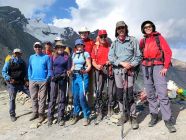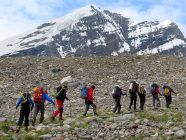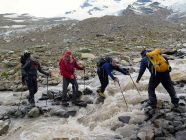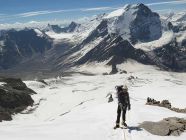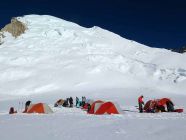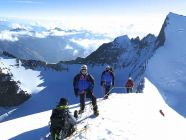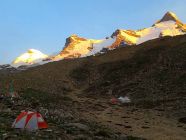A little after 11.00am on the morning of 2nd August 11 members of the 2018 Jagged Globe expedition to Kun reached the 7087m summit. The group of 6 climbers and 5 Sherpas has set out from Camp 3 (6300m) at 1.00am and the climb had taken over 10 hours. The weather was perfect and there were clear views as far as Nanga Parbat to the west and the Zanskar peaks to the East.
The climb to the summit took place 21 days after the team arrived in Ladakh, and 14 days after they established base camp. The calculated and cautious acclimatisation strategy adopted undoubtedly contributed to the success of the expedition, as none of the climbers suffered any symptoms of altitude illness during the climb.
The team arrived in Leh, the capital of Ladakh, via Delhi in the middle of July. They then had a few days to get used to the thin air of the Himalayas and explore the fascinating Buddhist culture of this remote region located in the NW corner of India.
The next phase of the acclimatisation program involved a 3 day trek from Hanupata to Kanji, spending 3 nights camped above 4,000m and crossing a 5050m pass. This was followed by a drive to Kargil on the spectacular mountain road 'National Highway 1', and an overnight in this town close to the Pakistan frontier. The next day the team drove East on the road towards Zanskar stopping at Shafat Nalah 3930m. This where the trek to Base Camp started and the next morning a dozen horses were hired to carry the team's loads for the 8 hour journey.
The cook team had gone on ahead and Base Camp (4550m) was up and running by the time the team arrived. The location was pleasant with clear running water, grass and flowers. There was a clear view of Nun, the other 7000m peak in the area, but Kun itself was hidden behind other lower peaks.
The team of 7 Sherpas began moving loads to the 3 camps that would be needed on the mountain and the climbers began the 14 days of training and acclimatisation that would eventually lead to the successful summit bid. This started with a round trip from BC to Camp 1 on July 21st followed by an overnight stay at Camp 1 on July 23rd. From BC the first half of the climb to Camp 1 (5400m) was on rocky ground and the second half on a glacier.
The third rotation above BC on 26/27/28 July saw the team sleep at Camp 1 and Camp 2 (6130m) before descending again to base. Camp 2 is situated at the edge of a large plateau surrounded by several high peaks including the 7000m summits of Nun and Kun. The route from Camp 1 is fairly straightforward but is steep in places (up to 35 degrees) and occasionally icy. This was protected by 1000m or fixed rope, some left by a previous military expedition, and some fixed by the JG Sherpas. After a single night sleeping above 6000m it was time to return to BC and prepare for the summit climb.
Throughout the climb the weather had been far from ideal with very little sunshine and lots of mist, low clouds, wind, rain and snow. The forecast indicated a possible improvement at the start of August and the team left BC on 30th July aiming for a 5 day round trip, but with sufficient supplies to spend a few extra days if needed.
A fully equipped Camp 1 was left in place and a well stocked Camp 2 established on 31st July. The following day supplies for 2 days were moved to Camp 3 (6300m) at the north side of the plateau, 1.2km from the summit of Kun, and the team occupied the tents that had been moved from Camp 2.
A weather check at midnight indicated clear skies and a decision was made to start climbing at 01.00am. Conditions remained clear and reasonably warm for an hour, then it became much colder as mist and fog enveloped the mountain. Leaving Camp 3 the route was level for a short distance before steepening to join the ridge linking Kun to Pinnacle Pk (6930m). The trail joined this ridge at it's lowest point approximately 250m above Camp 3, at a height of 6550m, and continued on a rising traverse 10-20m below the ridge crest on icy slopes. It was now cold, dark and foggy with little to see. The hours before dawn passed slowly with little way of measuring progress. By the time dawn lit the sky a little before 05.00am the mist had cleared and the route to the summit was visible. A section of narrow ridge between 6700m and 6800m had to be negotiated with care and the team were grateful for the additional fixed rope placed by the Sherpa team climbing in front.
From 6800m the angle of the slope eased and conditions underfoot were less icy. For the first time since leaving Camp 3, eight hours before, there was as flat spot suitable for resting. The team took their first break and contemplated the slopes ahead lit by the early morning sun.
Summit slopes of little more than 20 degrees were less challenging than the steep sections lower on the climb but soft snow sapped strength and slowed progress. With clear skies and little wind it became apparent for the first time that the summit was within reach if only the climbers could keep going.
The leading team reached the top a little before 11.00 and the two following teams arrived within the next 30 minutes. Everyone took time to admire the views and take pictures before beginning the descent. An hour after leaving the summit the mist closed in on the peak and this served to emphasise how lucky the team had been with the choice os summit day. Parts of the descent were a little tricky despite the presence of over 2000m of fixed rope. The leading group made it back to Camp 3 after a 14 hour day, but for those at the back it was a 16 hour round trip.
The following day everyone made the long hike back to BC, pausing to collect items left at Camps 2 and 1. The Sherpas did a great job carrying all the equipment off the mountain.
Kun is not a busy peak by Himalayan standards. A total of four groups attempted it in 2018, and two of these were large Indian military teams. It is difficult to get accurate figures on how many climbers are successful in reaching the summit but it seems to be well below 50% and may be as low as 25%. Most unsuccessful climbers blame the weather, and it is undoubtedly true that some well organised, strong teams can be thwarted by bad weather. However it seems that most local operators and Indian teams try to climb the mountain in a 10 day period from arriving at BC. This barely gives people time to acclimatise properly and includes no reserve days for bad weather. One of the main reasons that the 2018 Jagged Globe team were so successful was that they had a total of 17 days at, or above, BC in which to complete the climb. Additionally they were an experienced, strong and capable group of climbers supported by an excellent Sherpa crew.
David Hamilton (7th August 2018, Leh, Ladakh, India)

